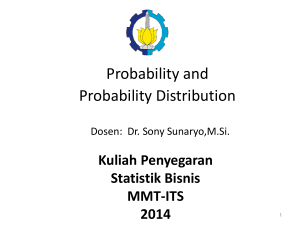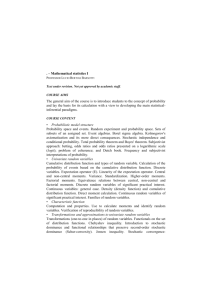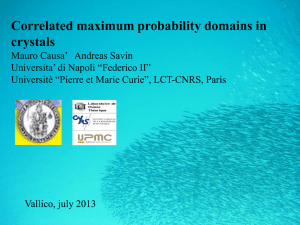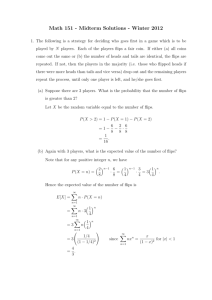Slide 1 - Website Staff UI
advertisement
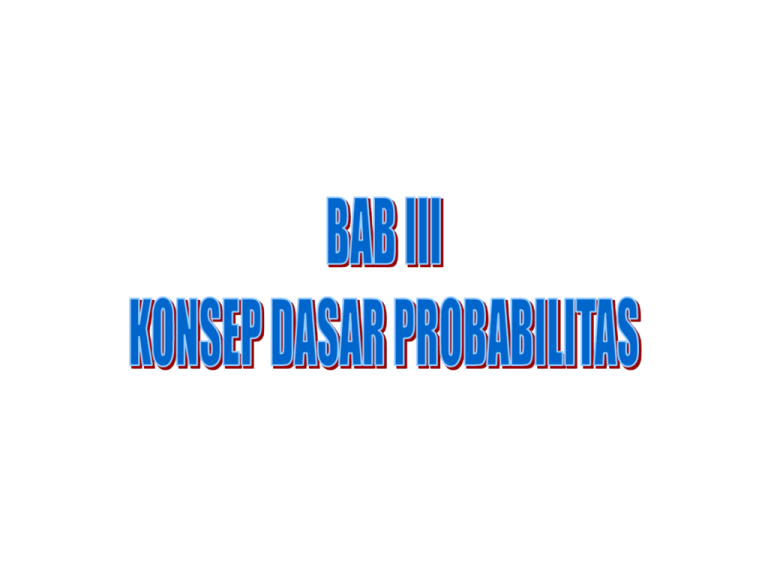
Tujuan Pembelajaran
• Mendefinisikan terminologi-terminologi penting
dalam probabilitas dan menjelaskan bagaimana
probabilitas kejadian sederhana ditentukan
• Memahami dan menjelaskan konsep-konsep
mengenai kejadian-kejadian bersyarat, bebas dan
mutually exclusive
• Menggunakan dengan benar dan tepat aturan
perkalian dan penjumlahan dalam melakukan
perhitungan probabilitas
• Memahami dan menggunakan analisis kombinatorial
untuk kejadian kompleks: permutasi dan kombinasi
AGENDA
• Pendahuluan
• Permutasi dan Kombinasi
• Konsep Probabilitas
1. Pendahuluan
• Probabilitas
– intepretasi keluaran peluang yang terjadi dalam suatu
percobaan
– Tingkat kepastian dari munculnya hasil percobaan
statistik
– Dilambangkan dengan P
• Konsep probabilitas dari permainan yang dilakukan
pengamatan untuk diperoleh fakta (empiris)
kemudian diformulakan kedalam konsep dan
dilakukan pengujian
• Matematika permutasi dan kombinasi banyak
digunakan
2. Permutasi dan Kombinasi
• Faktorial
n! = n(n-1)(n-2)…3.2.1
0! = 1 dan 1! = 1
• Permutasi
susunan yang dibentuk dari anggota suatu
himpunan dengan mengambil seluruh atau
sebagian anggota himpunan dan memberi arti
pada urutan anggota dari susunan
n!
n Pr
n r !
2. Permutasi dan Kombinasi
• Permutasi dari sebagian anggota yang
sama. Banyaknya permutasi yang
berlainan dari n sampel bila n1 berjenis I,
n2 berjenis II, …, nk berjenis k
n
n!
n1 n2 nk n1!n2! nk !
2. Permutasi dan Kombinasi (Con’t)
• Contoh
Himpunan {a,b,c}
diambil 3 anggota, diperoleh susunan:
abc; acb; bac; bca; cab; cba
3!
6
3 P3
3 3!
diambil 2 anggota, diperoleh susunan:
ab; ba; bc; cb; ac; ca
3 P2
3!
6
3 2!
2. Permutasi dan Kombinasi (Con’t)
• Kombinasi
susunan yang dibentuk dari anggota suatu
himpunan dengan mengambil seluruh atau
sebagian anggota himpunan dan tanpa
memberi arti pada urutan anggota dari
susunan
n
n!
n
Cr
r r !n r !
Contoh: himpunan {a,b,c} diambil 2 anggota,
diperoleh susunan: ab; bc; ca
{Permutasi ab = ba; bc = cb; ca = ac}
3. Konsep Probabilitas
• Derajat/tingkat kepastian dari munculnya hasil
percobaan statistik disebut probabilitas/peluang,
P
• Bila kejadian E terjadi dalam m cara dari seluruh
n cara yang mungkin terjadi dan mempunyai
kesempatan yang sama untuk muncul
m
P E
n
• Jika kejadian E terjadi sebanyak f kali dari
seluruh pengamatan sebanyak n, dimana n
mendekati tak berhingga, maka probabilitas
kejadian E
f
P E lim
n
n
3. Konsep Probabilitas
• Definisi Klasik
– Jika sebuah peristiwa A dapat terjadi dengan
fA cara dari sejumlah total N cara yang
mutually exclusive dan memiliki kesempatan
sama untuk terjadi, maka probabilitas
terjadinya peristiwa A dinotasikan dengan P(A)
dan didefinisikan sebagai:
f
P ( A)
A
N
– Sedangkan probabilitas tidak terjadinya suatu
peristiwa A atau komplemen A (sering disebut
kegagalan A) dinyatakan sebagai:
P ( A ) P ( A) P (~ A)
N fA
f
1 A 1 P ( A)
N
N
3. Konsep Probabilitas
• Definisi Frekuensi Relatif
– Seandainya pada sebuah eksperimen yang
dilakukan sebanyak N kali dan kejadian A
terjadi sebanyak fA kali, maka jika eksperimen
tersebut dilakukan tak terhingga kali
banyaknya (N mendekati tak hingga), nilai limit
dari frekuensi relatif fA/N didefinisikan
sebagai probabilitas kejadian A atau P(A).
fA
P ( A) lim
N N
3. Konsep Probabilitas
• Definisi Subyektif (Intuitif)
– Dalam hal ini, probabilitas P(A) dari terjadinya
peristiwa A adalah sebuah ukuran dari “derajat
keyakinan” yang dimiliki seseorang terhadap
terjadinya peristiwa A. Definisi ini mungkin
merupakan definisi yang paling luas digunakan
dan diperlukan jika sulit diketahui besarnya
ruang sampel maupun jumlah event yang dikaji
maupun jika sulit dilakukan pengambilan sampel
(sampling) pada populasinya.
3. Konsep Probabilitas
– Contoh:
Suatu strategi perang memilih salah satu di antara dua
alternatif yang masing-masing memberikan akibat
berbeda, yaitu menjatuhkan bom atau tidak menjatuhkan
bom ke daerah musuh. Karena masing-masing alternatif
itu tidak bisa diuji coba secara eksperimen untuk
mengetahui bagaimana musuh akan memberikan reaksi,
maka kita harus percaya pada “penilaian dari ahli (expert
judgement)” untuk menentukan probabilitas dari akibat
yang akan muncul. Situasi yang sama terjadi pula misalnya
dalam meramalkan siapa yang akan menjuarai suatu
turnamen sepakbola. Dalam hal ini, interpretasi klasik dan
frekuensi dari probabilitas tidak akan banyak gunanya,
dan suatu penilaian yang subyektif dari pengamat sepak
bola yang handal lebih diperlukan.
3. Konsep Probabilitas
• Himpunan semua hasil yang mungkin terjadi
pada suatu percobaan statistik disebut
ruang sampel,S; anggota dari S disebut
sampel
– Pada pelemparan mata uang S={m,b}
– Pada pelemparan dadu S = {1, 2, 3, 4, 5, 6}
– Untuk ruang sampel yang besar dinyatakan
dengan pernyataan atau aturan
• Himpunan dari hasil yang muncul pada
suatu percobaan statistik disebut kejadian
(event), A; Anggota dari A disebut titik
sampel
3. Konsep Probabilitas
• Diagram Venn
S
A
Konsep Probabilitas
- Ruang sampel, S
- Kejadian, A
- Titik sampel
A
Teori Himpunan
- Himpunan semesta S
- Himpunan bagian A
- Anggota himpunan
3. Konsep Probabilitas
• Bila kejadian A terjadi dalam m cara pada
ruang sampel S yang terjadi dalam n cara,
maka probabilitas kejadian A adalah
P A
n( A) m
n( S ) n
• Sifat probabilitas kejadian A
– 0 < P(A) < 1
– Bila A = 0, maka P(A) = 0
– Bila A = S, maka P(A) = 1
3. Konsep Probabilitas
• A B = daerah 1 dan 4
• B C = daerah 1 dan 3
• A C = daerah 1 dan 2
• A B = daerah 1, 2, 3, 4, 5, dan 6
• B C = daerah 1, 2, 3, 4, 6, dan 7
• A C = daerah 1, 2, 3, 4, 5, dan 7
•A B C = daerah 1
• B A = daerah 2 dan 5
• ( A B) C = daerah 4, 5, dan 6
5
A
4
2 1 3
C
7
6
B
S
3. Konsep Probabilitas
• Aksioma teori himpunan
3. Konsep Probabilitas
• Probabilitas A B dan A B
A
A
B
A B
B
A
A B
A
A
P A B P( A) PB P A B
3. Konsep Probabilitas
• De-Morgan Law
A B A B ;
A
B
A B
A
B
A B
A B A B
A
B
A B
A
B
3. Konsep Probabilitas
• Dua Kejadian Mutually Exclusive (ME)
Dua kejadian ME terjadi bila A dan B dua
kejadian sembarang pada S dan berlaku A B 0.
A & B saling meniadakan; terjadinya A akan
mencegah terjadinya B, dan sebaliknya.
A
B
A B
P A B P( A) P( B)
3. Konsep Probabilitas
• Dua Kejadian Saling Bebas
Dikatakan saling bebas jika kejadian A
tidak mempengaruhi kejadian B dan
sebaliknya kejadian B tidak
mempengaruhi kejadian A
P A B P( A) P( B)
3. Konsep Probabilitas
• Axioms of Probability
• For any event A, we assign a number P(A), called
the probability of the event A. This number
satisfies the following three conditions that act
the axioms of probability.
(i) P( A) 0 (Probabili ty is a nonnegativ e number)
(ii) P() 1 (Probabili ty of the whole set is unity)
(iii) If A B , then P( A B ) P( A) P( B ).
•
(Note that (iii) states that if A and B are
mutually exclusive (M.E.) events, the probability
of their union is the sum of their probabilities.)
The following conclusions follow from these axioms:
a. Since A A S , we have using (ii)
P( A A) P () 1.
But A A , and using (iii),
P( A A) P( A) P( A) 1 or P( A) 1 P( A). (1-10)
b. Similarly, for any A, A .
Hence it follows that P A P( A) P( ) .
But A A, and thus P 0.
(1-11)
c. Suppose A and B are not mutually exclusive (M.E.)?
How does one compute P( A B ) ?
PILLAI
To compute the above probability, we should re-express
A B in terms of M.E. sets so that we can make use of
the probability axioms. From Fig.1.4 we have
(1-12)
A B A AB,
where A and AB are clearly M.E. events.
Thus using axiom (1-9-iii)
A
AB
A B
Fig.1.4
P( A B ) P( A AB ) P( A) P( AB ). (1-13)
To compute P ( AB ), we can express B as
B B S B ( A A)
Thus
( B A) ( B A) BA B A
P( B ) P( BA) P( B A),
(1-14)
(1-15)
since BA AB and B A AB are M.E. events.
PILLAI
From (1-15),
P( AB ) P( B ) P( AB)
(1-16)
and using (1-16) in (1-13)
P( A B ) P( A) P( B ) P( AB).
(1-17)
PILLAI
3. Konsep Probabilitas
• Probabilitas Bersyarat
probabilitas terjadinya kejadian A bila
kejadian B telah terjadi
P( A B)
P A B
atau P( A B) PA B P( B)
P( B)
• Untuk dua kejadian saling bebas
PA B P( A) dan PB A P( B)
Properties of Conditional Probability:
a. If B A, AB B, and
P( A | B)
P( AB) P( B)
1
P( B)
P( B)
(1-36)
since if B A, then occurrence of B implies automatic
occurrence of the event A. As an example, but
A {outcome is even}, B={outcome is 2},
in a dice tossing experiment. Then B A, and P( A | B ) 1.
b. If A B, AB A, and
P( AB) P( A)
P( A | B )
P( A).
P( B )
P( B )
(1-37)
PILLAI
We have
(i)
P( AB) 0
P( A | B )
0,
P( B ) 0
(ii)
P( S | B)
P(B) P( B)
1,
P( B)
P( B)
(1-32)
since S B = B.
(1-33)
(iii) Suppose A C 0. Then
P( A C | B )
P(( A C ) B) P( AB CB)
.
P( B )
P( B )
(1-34)
But AB AC , hence P( AB CB) P( AB) P(CB).
P( AB) P(CB)
P( A C | B )
P( A | B) P(C | B),
P( B )
P( B )
(1-35)
satisfying all probability axioms in (1-9). Thus (1-31)
defines a legitimate probability measure.
PILLAI
(In a dice experiment, A {outcome is 2}, B={outcome is even},
so that A B. The statement that B has occurred (outcome
is even) makes the odds for “outcome is 2” greater than
without that information).
c. We can use the conditional probability to express the
probability of a complicated event in terms of “simpler”
related events.
Let A1, A2 ,, An are pair wise disjoint and their union is .
n
Thus Ai Aj , and
(1-38)
A .
i
i 1
Thus
B B( A1 A2 An ) BA1 BA2 BAn . (1-39)
PILLAI
But Ai Aj BAi BA j , so that from (1-39)
P( B )
n
n
P( BA ) P( B | A ) P( A ).
i 1
i
i 1
i
i
(1-40)
With the notion of conditional probability, next we
introduce the notion of “independence” of events.
Independence: A and B are said to be independent events,
if
P ( AB ) P ( A) P ( B ).
(1-41)
Notice that the above definition is a probabilistic statement,
not a set theoretic notion such as mutually exclusiveness.
PILLAI
Suppose A and B are independent, then
P( AB)
P( A) P( B )
P( A | B )
P( A).
P( B )
P( B )
(1-42)
Thus if A and B are independent, the event that B has
occurred does not shed any more light into the event A. It
makes no difference to A whether B has occurred or not.
An example will clarify the situation:
Example 1.2: A box contains 6 white and 4 black balls.
Remove two balls at random without replacement. What
is the probability that the first one is white and the second
one is black?
Let W1 = “first ball removed is white”
B2 = “second ball removed is black”
PILLAI
We need P(W1 B2 ) ? We have W1 B2 W1B2 B2W1.
Using the conditional probability rule,
P(W1B2 ) P( B2W1 ) P( B2 | W1 ) P(W1 ).
But
and
(1-43)
6
6
3
P(W1 )
,
6 4 10 5
4
4
P( B2 | W1 )
,
54 9
and hence
5 4 20
P (W1 B2 )
0.25.
9 9 81
PILLAI
Are the events W1 and B2 independent? Our common sense
says No. To verify this we need to compute P(B2). Of course
the fate of the second ball very much depends on that of the
first ball. The first ball has two options: W1 = “first ball is
white” or B1= “first ball is black”. Note that W1 B1 ,
and W1 B1 . Hence W1 together with B1 form a partition.
Thus (see (1-38)-(1-40))
P( B2 ) P( B2 | W1 ) P(W1 ) P( B2 | R1 ) P( B1 )
4 3
3
4 4 3 1 2 42 2
,
5 4 5 6 3 10 9 5 3 5
15
5
and
2 3
20
P ( B2 ) P (W1 ) P ( B2W1 )
.
5 5
81
As expected, the events W1 and B2 are dependent.
PILLAI
From (1-31),
P( AB ) P( A | B ) P( B ).
(1-44)
Similarly, from (1-31)
P( B | A)
or
P( BA)
P( AB)
,
P( A)
P( A)
P( AB ) P( B | A) P( A).
(1-45)
From (1-44)-(1-45), we get
P( A | B ) P( B ) P( B | A) P( A).
or
P( A | B )
P( B | A)
P( A)
P( B )
(1-46)
Equation (1-46) is known as Bayes’ theorem.
PILLAI
Although simple enough, Bayes’ theorem has an interesting
interpretation: P(A) represents the a-priori probability of the
event A. Suppose B has occurred, and assume that A and B
are not independent. How can this new information be used
to update our knowledge about A? Bayes’ rule in (1-46)
take into account the new information (“B has occurred”)
and gives out the a-posteriori probability of A given B.
We can also view the event B as new knowledge obtained
from a fresh experiment. We know something about A as
P(A). The new information is available in terms of B. The
new information should be used to improve our
knowledge/understanding of A. Bayes’ theorem gives the
exact mechanism for incorporating such new information.
PILLAI
A more general version of Bayes’ theorem involves
partition of . From (1-46)
P ( B | Ai ) P ( Ai )
P ( Ai | B )
P( B )
P ( B | Ai ) P ( Ai )
n
P( B | A ) P( A )
i 1
i
,
(1-47)
i
where we have made use of (1-40). In (1-47), Ai , i 1 n,
represent a set of mutually exclusive events with
associated a-priori probabilities P( Ai ), i 1 n. With the
new information “B has occurred”, the information about
Ai can be updated by the n conditional probabilities
P( B | Ai ), i 1 n, using (1 - 47).
PILLAI
Example 1.3: Two boxes B1 and B2 contain 100 and 200
light bulbs respectively. The first box (B1) has 15 defective
bulbs and the second 5. Suppose a box is selected at
random and one bulb is picked out.
(a) What is the probability that it is defective?
Solution: Note that box B1 has 85 good and 15 defective
bulbs. Similarly box B2 has 195 good and 5 defective
bulbs. Let D = “Defective bulb is picked out”.
Then
P( D | B1 )
15
0.15,
100
P ( D | B2 )
5
0.025.
200
PILLAI
Since a box is selected at random, they are equally likely.
P ( B1 ) P ( B2 )
1
.
2
Thus B1 and B2 form a partition as in (1-39), and using
(1-40) we obtain
P( D) P( D | B1 ) P( B1 ) P( D | B2 ) P( B2 )
0.15
1
1
0.025 0.0875.
2
2
Thus, there is about 9% probability that a bulb picked at
random is defective.
PILLAI
(b) Suppose we test the bulb and it is found to be defective.
What is the probability that it came from box 1? P( B1 | D) ?
P( B1 | D)
P( D | B1 ) P( B1 ) 0.15 1 / 2
0.8571.
P ( D)
0.0875
(1-48)
Notice that initially P( B1 ) 0.5; then we picked out a box
at random and tested a bulb that turned out to be defective.
Can this information shed some light about the fact that we
might have picked up box 1?
From (1-48), P( B1 | D) 0.857 0.5, and indeed it is more
likely at this point that we must have chosen box 1 in favor
of box 2. (Recall box1 has six times more defective bulbs
compared to box2).
PILLAI
3. Konsep Probabilitas
S
A1
A2
A3
B B A1 B A2 B A3
P( B) P( B A1 ) P( A1 ) P( B A2 ) P( A2 ) P( B A3 ) P( A3 )
3. Konsep Probabilitas
P( B A1 ) P( A1 )
PB A1
P( B A1 )
P( B)
PB Ai P( Ai )
P( B A2 ) P( A2 )
PB A2
P( B A2 )
P( B)
PB Ai P( Ai )
P( B A3 ) P( A3 )
PB A3
P( B A3 )
P( B)
PB Ai P( Ai )
P( B Ai ) P( Ai )
PB Ai
P( B Ai )
P( B)
PB Ai P( Ai )
